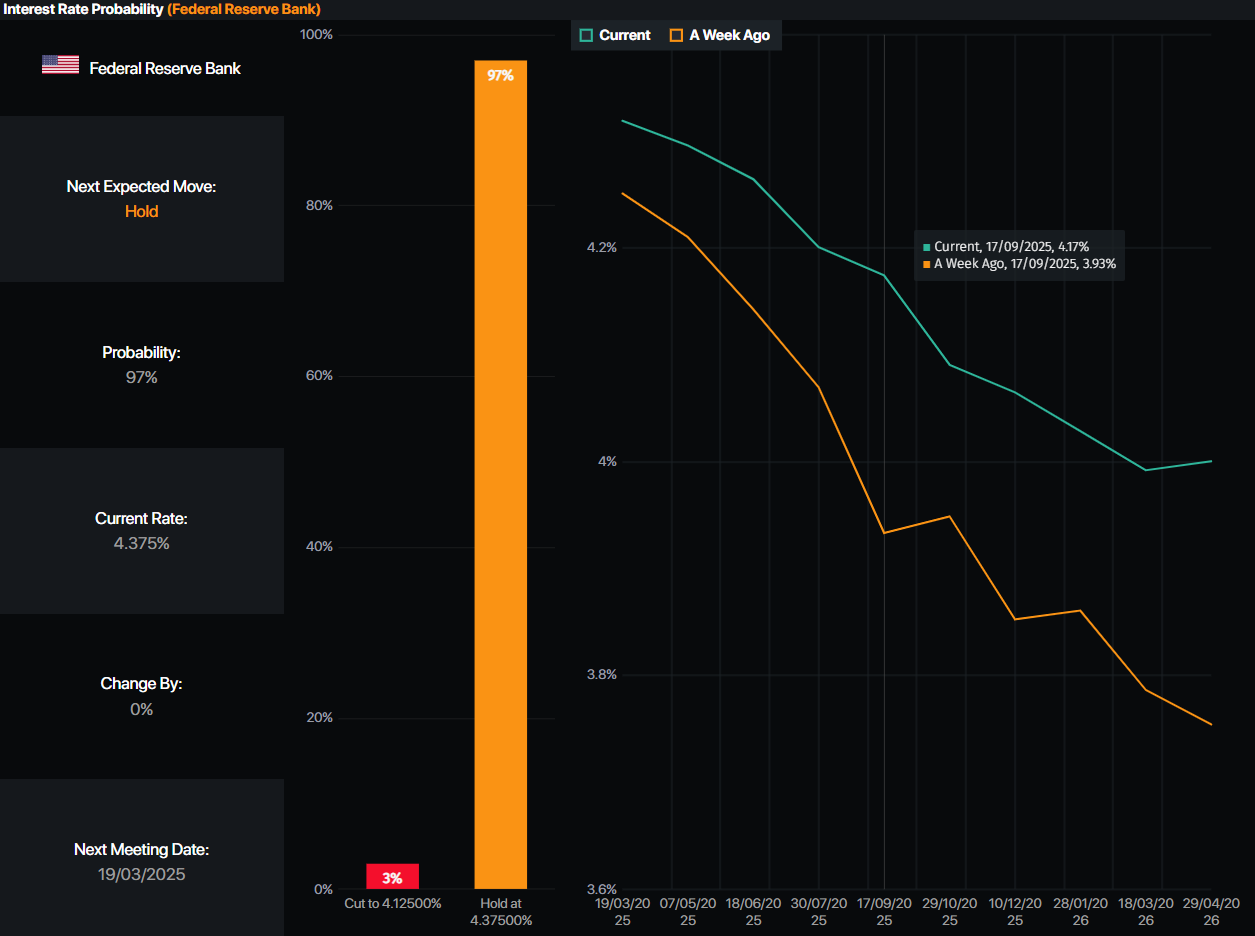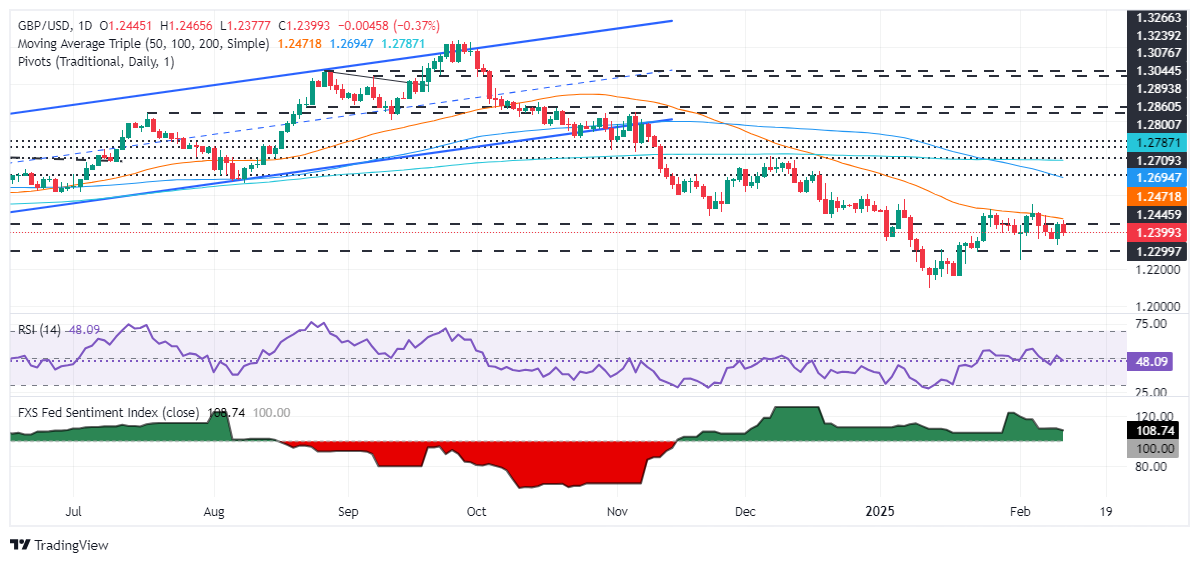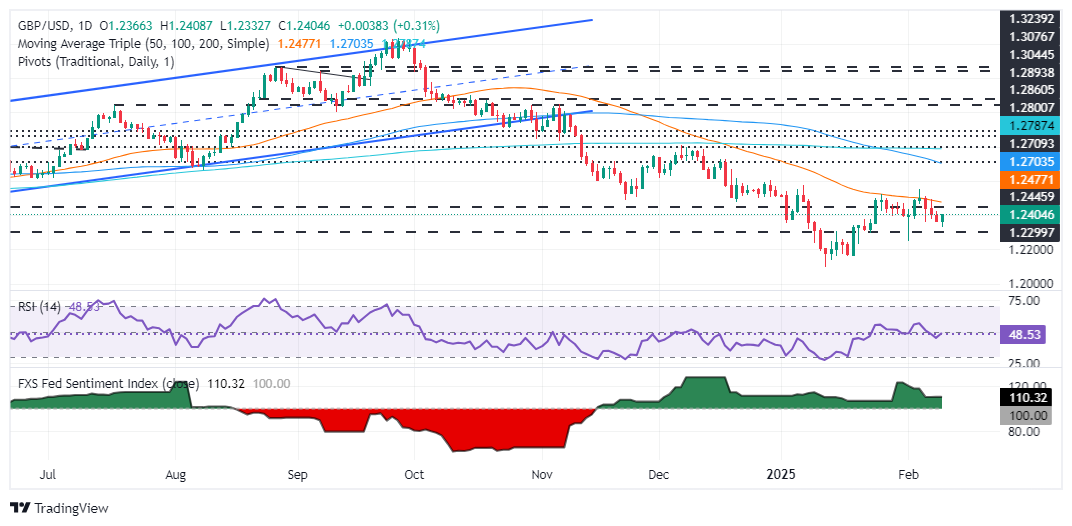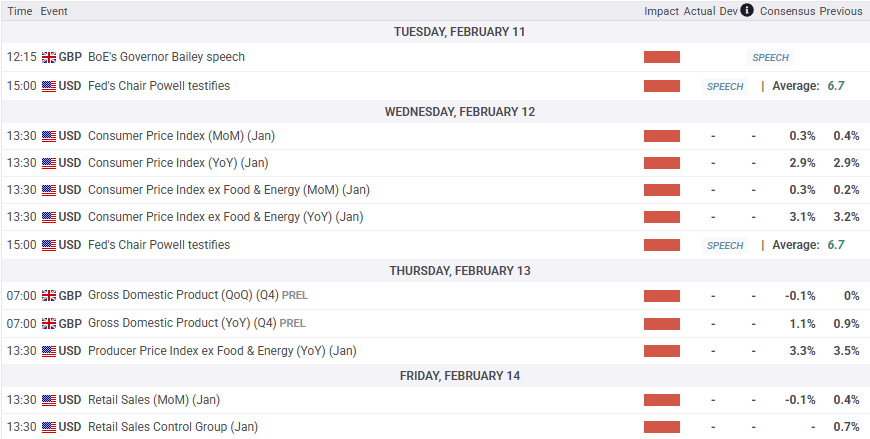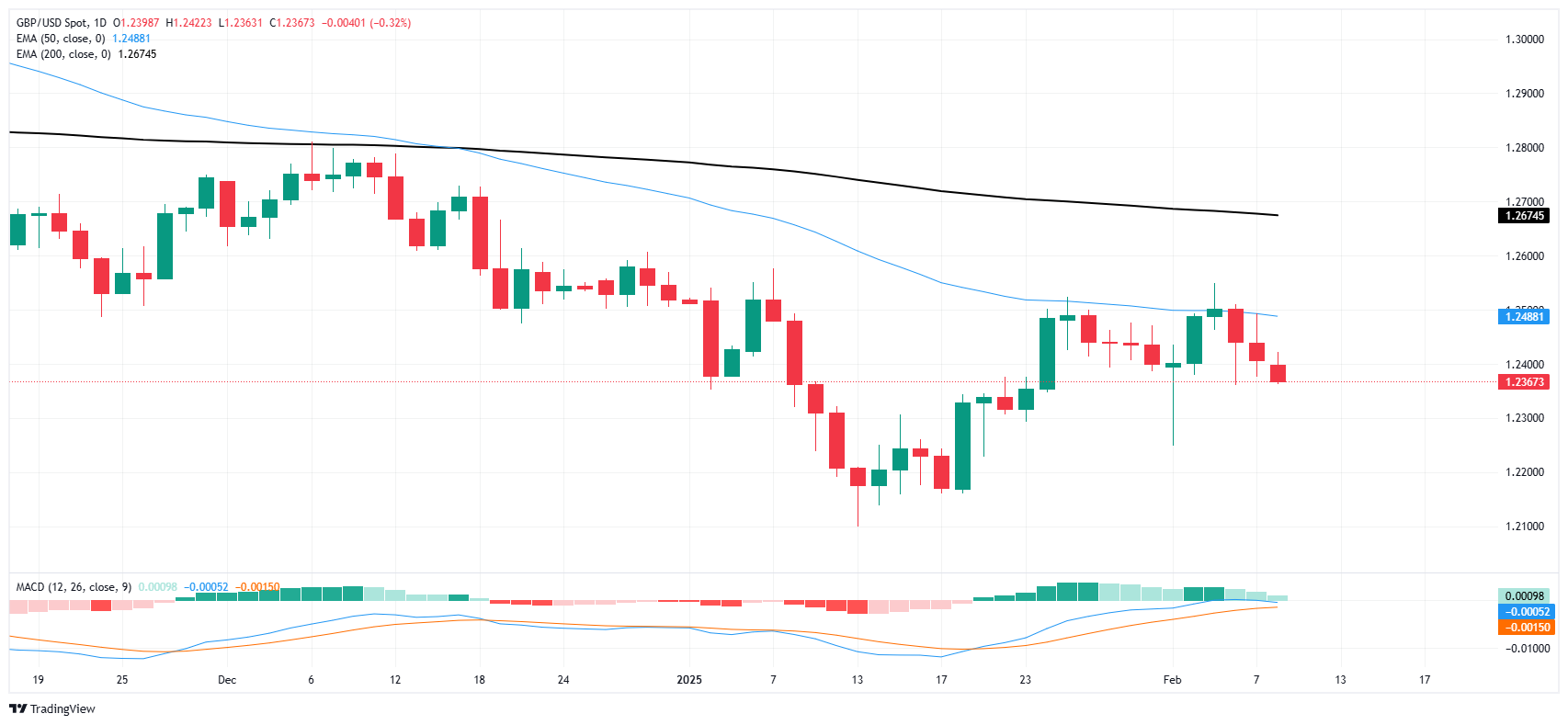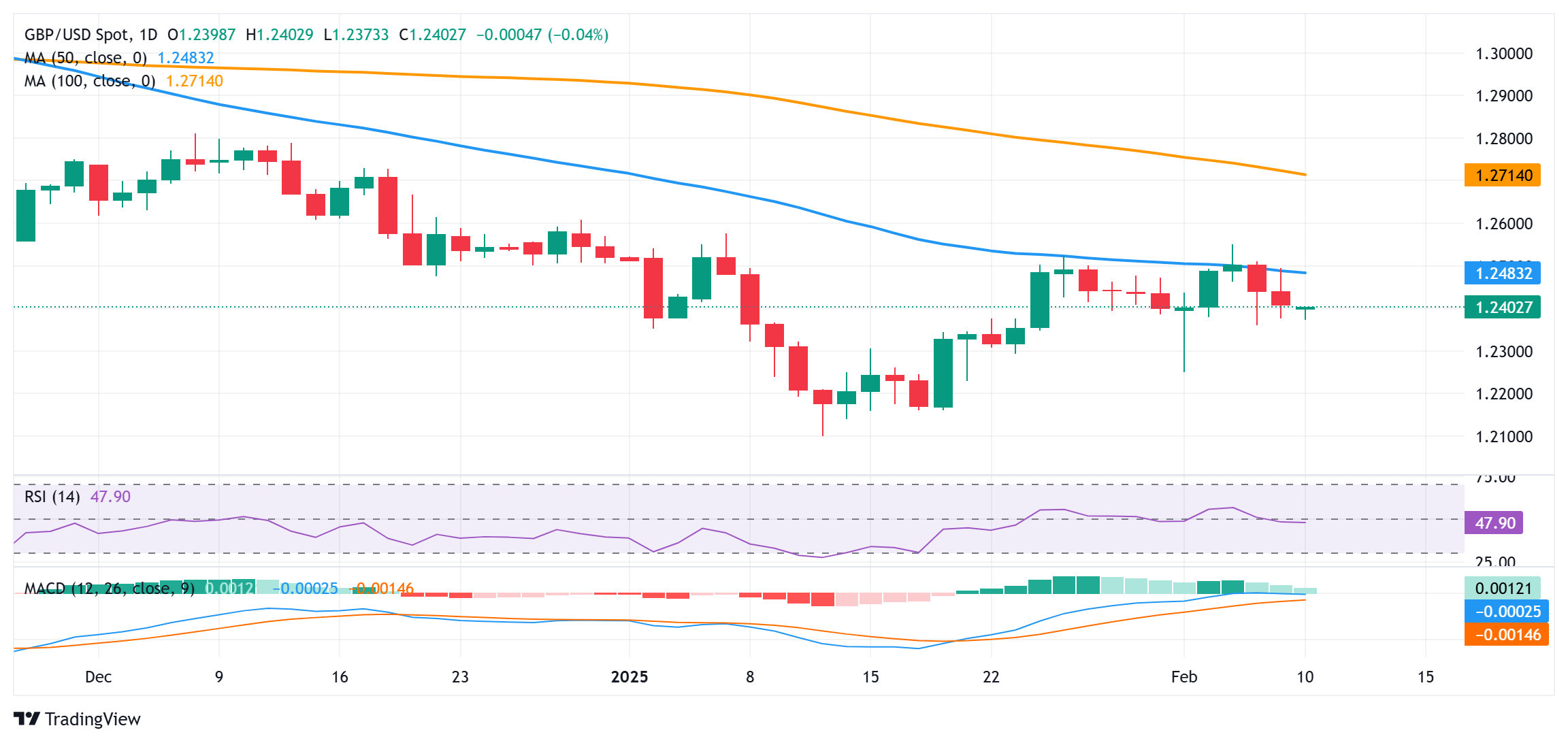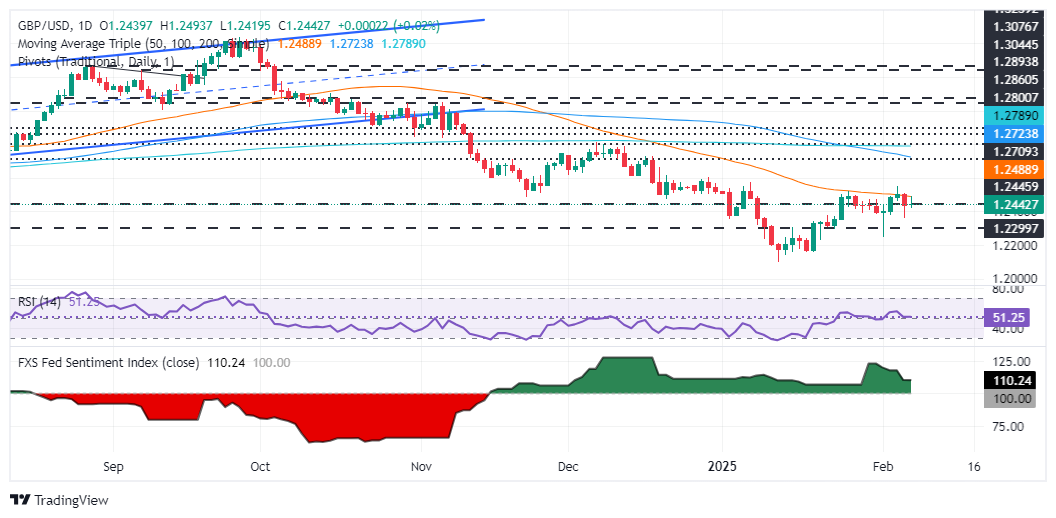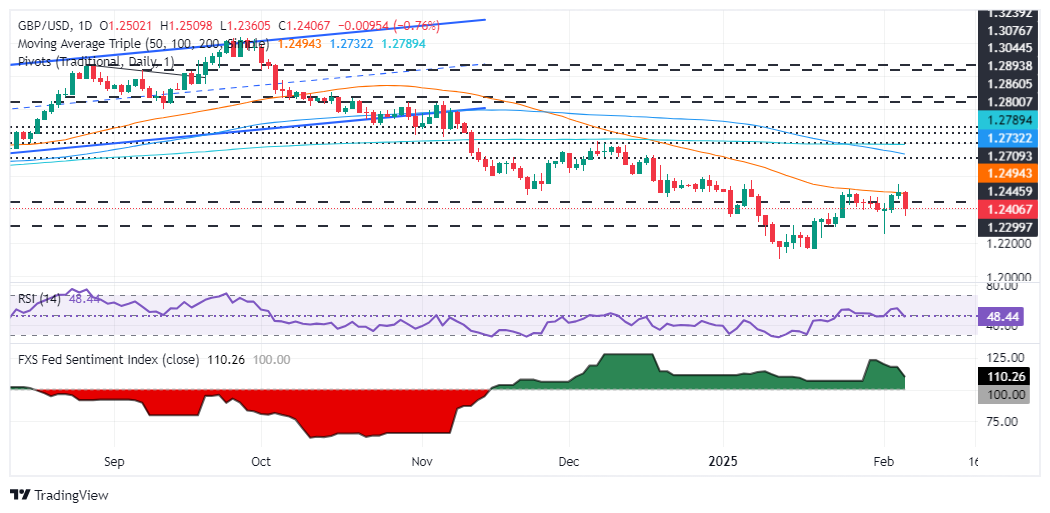- Analytics
- News and Tools
- Quotes
- Chart and quotes for GBPUSD
CFD Trading Rate Great Britain Pound vs US Dollar (GBPUSD)
| Date | Rate | Change |
|---|
Related news
-
12.02.2025 14:57GBP/USD drops below 1.2400 after US CPI data
- GBP/USD hits a daily low of 1.2374 as US inflation jumps above 3%.
- The US Dollar strengthens as investors expect Fed's first rate cut until September 2025.
- If GBP/USD prints a daily close below 1.2400, sellers would target 1.2300.
The Pound Sterling slipped during the North American session after the latest United States (US) inflation report showed that prices continued to rise, pushing back expectations of a Federal Reserve rate cut in the first half of 2025. The GBP/USD trades at 1.2387, down 0.47%.
Pound dips as US inflation surges
Inflation reaccelerates in the US, as the US Bureau of Labor Statistics (BLS) reveals. The Consumer Price Index (CPI) rose above 3% YoY for the first time since June 2024. Month-over-month (MoM) figures jumped 0.5%, up from December’s 0.4%. In the meantime, excluding volatile items, CPI increased by 3.3% YoY from 3.2%, and MoM expanded by 0.4%, up from 0.2%, exceeding estimates of 0.3%.
After the data, investors expect the first rate cut until September, according to data from Prime Market Terminal. The swaps market had priced in 20 basis points of easing toward the September 17 meeting, down from last week’s 45 bps.
Source: Prime Market Terminal
In the UK, the National Institute of Economic and Social Research (NIESR) predicts the Bank of England (BoE) has little room to cut rates further and predicts the BoE will cut rates once in 2025 and again in 2026.
This week, traders are eyeing Fed Chair Jerome Powell's testimony at the US House of Representatives. Besides him, Atlanta’s Fed Bostic and Governor Waller would cross the wires.
In the UK, the docket will feature Gross Domestic Product (GDP) figures for Q4 2024. Economists expect the economy to contract by -0.1% QoQ, yet on an annual basis, they estimate growth of 1.1%, up from Q3's 0.9%.
GBP/USD Price Forecast: Technical outlook
GBP/USD price action indicates the pair remains tilted to the downside but is set to consolidate within the 1.2330 - 1.2450 area. The Relative Strength Index (RSI) suggests that momentum remains bearish, opening the door for further selling pressure in the pair.
A daily close below 1.2400 could sponsor a leg toward the February 11 low of 1.2332, followed by the February 3 low of 1.2248. On further weakness, 1.22000 is up next. Conversely, if GBP/USD rises past 1.2400 and challenges the 50-day Simple Moving Average (SMA) at 1.2475, the exchange rate could aim towards 1.2500.
British Pound PRICE Today
The table below shows the percentage change of British Pound (GBP) against listed major currencies today. British Pound was the strongest against the Japanese Yen.
USD EUR GBP JPY CAD AUD NZD CHF USD 0.16% 0.40% 1.24% 0.25% 0.68% 0.69% 0.14% EUR -0.16% 0.24% 1.07% 0.09% 0.52% 0.52% -0.02% GBP -0.40% -0.24% 0.80% -0.14% 0.28% 0.29% -0.26% JPY -1.24% -1.07% -0.80% -0.97% -0.54% -0.54% -1.07% CAD -0.25% -0.09% 0.14% 0.97% 0.43% 0.43% -0.11% AUD -0.68% -0.52% -0.28% 0.54% -0.43% 0.00% -0.54% NZD -0.69% -0.52% -0.29% 0.54% -0.43% -0.00% -0.54% CHF -0.14% 0.02% 0.26% 1.07% 0.11% 0.54% 0.54% The heat map shows percentage changes of major currencies against each other. The base currency is picked from the left column, while the quote currency is picked from the top row. For example, if you pick the British Pound from the left column and move along the horizontal line to the US Dollar, the percentage change displayed in the box will represent GBP (base)/USD (quote).
-
12.02.2025 08:29GBP/USD: Likely to continue to rise – UOB Group
-
12.02.2025 04:06GBP/USD holds gains near 1.2450, downside risks appear due to hawkish Fed
-
11.02.2025 22:50GBP/USD recovers on general sentiment improvement
-
11.02.2025 14:47GBP/USD climbs above 1.2400 as US Dollar weakens on tariff woes
-
11.02.2025 08:35GBP/USD: Downward momentum can lead to GBP edging lower – UOB Group
-
11.02.2025 04:09GBP/USD extends losses to near 1.2350 amid risk-off mood following Trump’s tariffs
-
10.02.2025 23:32GBP/USD sheds weight for a third straight day, central bank heads up next
-
10.02.2025 15:32GBP/USD tumbles below 1.2400, extends its losses
-
10.02.2025 10:21GBP/USD: Likely to trade in a 1.2310/1.2550 range – UOB Group
-
10.02.2025 05:14GBP/USD Price Forecast: Hovers around 1.2400; seems vulnerable while below 50-day SMA
-
10.02.2025 01:01GBP/USD holds below 1.2400 on firmer US Dollar
-
07.02.2025 15:17GBP/USD holds to earlier gains near 1.2450 post US jobs data
-
07.02.2025 10:11GBP/USD: Likely to trade in a 1.2310/1.2550 range – UOB Group
-
07.02.2025 04:31GBP/USD trades with negative bias around 1.2425 area, US NFP report awaited
-
06.02.2025 23:44GBP/USD pulls back after BoE rate cut
-
06.02.2025 15:07GBP/USD plummets as BoE cut rates unanimously
-
06.02.2025 13:45GBP/USD slides further after expected BoE rate cut – Scotiabank
-
06.02.2025 09:33GBP/USD: Above 1.2550 a sustained can be expected – UOB Group
-
06.02.2025 04:20GBP/USD steadies around 1.2500, downside risks appear due to dovish mood surrounding BoE
© 2000-2025. All rights reserved.
This site is managed by Teletrade D.J. LLC 2351 LLC 2022 (Euro House, Richmond Hill Road, Kingstown, VC0100, St. Vincent and the Grenadines).
The information on this website is for informational purposes only and does not constitute any investment advice.
The company does not serve or provide services to customers who are residents of the US, Canada, Iran, The Democratic People's Republic of Korea, Yemen and FATF blacklisted countries.
Making transactions on financial markets with marginal financial instruments opens up wide possibilities and allows investors who are willing to take risks to earn high profits, carrying a potentially high risk of losses at the same time. Therefore you should responsibly approach the issue of choosing the appropriate investment strategy, taking the available resources into account, before starting trading.
Use of the information: full or partial use of materials from this website must always be referenced to TeleTrade as the source of information. Use of the materials on the Internet must be accompanied by a hyperlink to teletrade.org. Automatic import of materials and information from this website is prohibited.
Please contact our PR department if you have any questions or need assistance at pr@teletrade.global.
